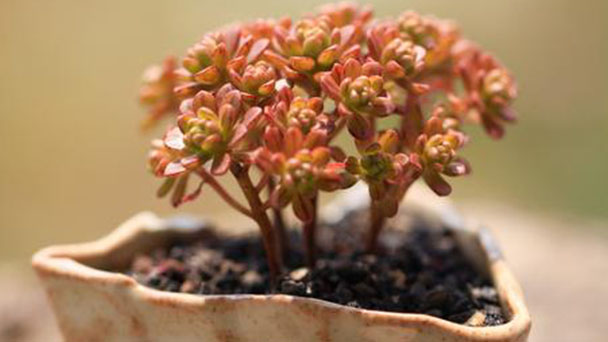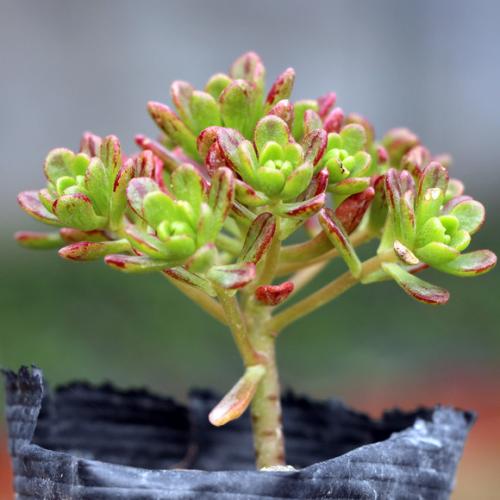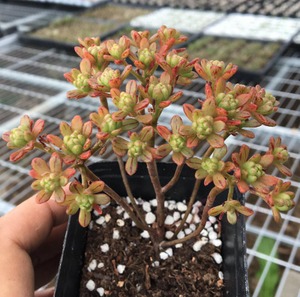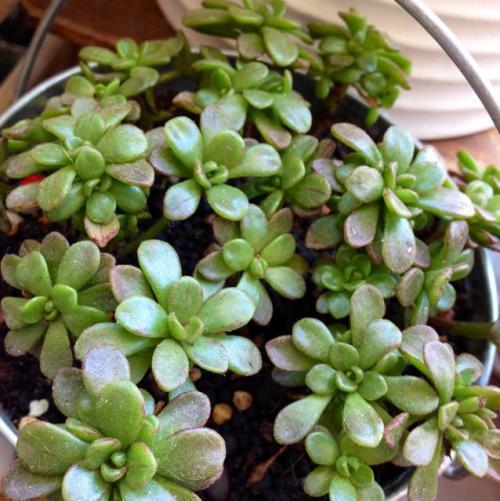Aeonium loartei profile
Written by Maggie
Mar 05 2021

Aeonium loartei is a succulent plant of the phylum Cereophora, subphylum Cereophora, class Magnolias, subclass Rosa, order Cereophora, family Chrysophora, family Lephylidae, genus Lephylidae. Aeonium loartei is derived from the cross of Aeonium loartei and Fact Child. Aeonium loartei is a perennial fleshy herb, smaller plant type, much branched, short stem, leaf compact rosette with branch tip, obovate, apex apex; Leaves are thick, grayish green, with a red edge if well lit.
Aeonium Loartei picture

Morphological Characteristics of Aeonium Loartei
Aeonium loartei is miniscule, much branched. Small oval leaves of aeonium loartei are arranged in the shape of lotus. The leaves are sticky, green with purple stripes in the middle and red edges at the edges. Under full light, the color of the leaves will change, and the purple texture will become more obvious. Aeonium Loartei in spring, racemes, small yellow flowers.
Aeonium loartei distribution range
Aeonium loartei is native to the Canary Islands, now the world can be cultivated in many places.
Aeonium Loartei growing environment
Aeonium Loartei has a strong habit. Aeonium loartei likes warm, dry and sunny conditions. It can withstand drought and is suitable for growing in open or semi-open water. They lie dormant in the summer, and when dormant the leaves are wrapped up. When Aeonium Loartei blooms, almost every branch will sprout flower buds. After flowering, the branch will dry out and die, but a new lateral bud will sprout from the lower part. Therefore, there is no need to worry about Aeonium Loartei dying after flowering. It is a succulent plant with very small leaves and body size. It is green at ordinary times. In spring and autumn when there is sufficient sunshine, the leaf color will become darker.
It is more suitable for individual planting. Due to its fast growth rate, the long branches and stumps can easily grow into a piece to cover other succulents. You can use this to create a separate landscape.
Sunshine: in the four seasons in addition to the summer to pay attention to appropriate shading, other seasons can be full sunshine. Temperature: The suitable temperature for Aeonium loartei growth is 15~32℃. The temperature in winter should not be lower than 10℃. When the temperature is lower than 5℃, attention should be paid to prevent freezing damage.

Growing methods of Aeonium Loartei
Aeonium loartei grows very fast in spring and is suitable for growing alone and can easily grow into a large mass. This season should be given sufficient light, if the long-term shady place will make the leaves without light, plant growth, and then lead to loose plant shape, affect the ornamental.
In summer, the Aeonium loartei will enter the dormant period and stop growing. At this time, we should pay attention to shading and maintain them in the environment of air circulation. A notable feature of Aeonium loartei's resting state is that the leaves hold together. The dormant period should be watered less and stop fertilizing.
As autumn cools down, Aeonium loartei wakes up from dormancy and enters the growing season. At this time to strengthen the supply of fertilizer and water nutrition, watering can be in accordance with the principle of "dry thoroughly watering", the appropriate extension of the watering time interval, so that the leaves are closer, the color is more bright green.
In winter, Aeonium loartei needs to be moved into indoor breeding, as far as possible to choose a sunny place, the temperature is not lower than 10℃ can be normal growth. If the temperature is below 5℃, stop watering.
Propagation of Aeonium Loartei
The main propagation method of Aeonium loartei is cuttage. In the spring and autumn growing season, when the temperature is about 15~20℃, you can cut a small section and insert it into the soil. The weather is too cold or too hot. Roots will not come out easily.It's easier to breed.
Aeonium loartei pest control
Rusty, leaf spot and root knot nematodes of Aeonium loartei can be treated with 75% chlorothalonil WP 800 times, and root knot nematodes with 3% Carbofuran granules.

Latest Updated
- Benefits of Bugleweed - 7 Science-backed Health Benefits
- Bugleweed Dangers & Side Effects - Is It Poisonous?
- How to Plant Evergreen Trees - What You Should Know
- When to Plant Evergreens - Grow Guide for Evergreen Trees
- 12 Wonderful Evergreen Shrubs for Your Garden
- 12 Popular Evergreen Plants with Pictures for Beginners
- When And How To Prune A Lilac Bush Like a Pro
- How to Grow & Care for Lilac Vine (Hardenbergia Violacea)
- Japanese Lilac Tree (Syringa Reticulata) Care & Propagation Guide
- Shumard Oak Pros and Cons - What to Know
Popular Articles
- Winter maintenance of Antirrhinum Majus
- How to Grow Terminalia Mantaly Tree
- How to Grow and Care for Crossostephium Chinense
- How to grow Antirrhinum Majus in spring
- Peristeria Elata (Dove Orchid) Profile: Info & Care Guide
- Underwatered Snake Plant (Sansevieria Trifasciata) - Signs And How To Fix
- How to Care for Brazilian Jasmine Plant (Mandevilla Sanderi)
- How to Grow & Care for Graptopetalum Purple Delight in Summer
- Rosa Chinensis (China Rose): Plant Growing & Care Tips
- How to Care for Baby Sun Rose (Aptenia Cordifolia)